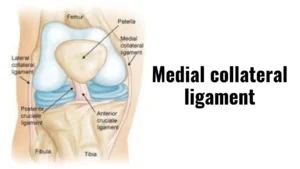Introduction/Overview
The anterior cruciate ligament (ACL) and medial collateral ligament (MCL) are two essential knee ligaments that provide stability and support during physical activities. An MCL tear is a common knee injury that occurs when the ligament on the inner aspect of the knee is stretched or torn. This type of injury often results from sudden twisting or direct impact to the knee, such as in sports or accidents. Understanding the symptoms, causes, diagnosis, management, and prevention of MCL tears is crucial in order to provide proper treatment and ensure a full recovery.

Symptoms and Causes
When an MCL tear occurs, individuals often experience pain and swelling around the inner part of the knee. This pain may be accompanied by a feeling of instability or weakness when walking or bearing weight on the affected leg. Moreover, a popping sound at the time of injury is not uncommon. MCL tears are usually caused by sudden twisting or inward stress to the knee joint, which can happen during sports activities like football or skiing, or due to a direct blow to the knee in accidents or falls.
Diagnosis and Tests
To diagnose an MCL tear, doctors often begin with a comprehensive physical examination. They will assess the range of motion of the knee, check for any signs of instability, and evaluate the level of pain or tenderness around the MCL area. In some cases, imaging tests like an MRI or an X-ray may be requested to confirm the diagnosis and assess the severity of the tear. An MRI scan can provide detailed images of the knee’s soft tissues, enabling doctors to identify the exact location and extent of the MCL tear.
Management and Treatment
The management and treatment of an MCL tear depend on the severity of the injury. For mild MCL tears, doctors often recommend the R.I.C.E method: rest, ice, compression, and elevation. Additionally, nonsteroidal anti-inflammatory drugs (NSAIDs) may be prescribed to alleviate pain and reduce swelling. Physical therapy is also an essential part of the treatment plan, focusing on strengthening the knee muscles and improving range of motion. In more severe cases, where the MCL is torn completely, surgery may be necessary to repair the ligament and restore knee stability.
Prevention
Preventing MCL tears involves taking certain precautions during physical activities. Warming up before participating in sports or exercise can help loosen the muscles and increase flexibility, reducing the risk of injury. Proper techniques and protective gear are also vital in preventing MCL tears. Athletes should ensure they are using the correct form and techniques when playing sports and wear appropriate knee braces or pads to protect their knees from direct impact. Maintaining overall strength and range of motion through regular exercise and conditioning can also help prevent MCL tears.
Outlook / Prognosis
The outlook for individuals with an MCL tear varies depending on the severity of the injury and the individual’s commitment to rehabilitation. With proper treatment and physical therapy, mild to moderate MCL tears can often heal without the need for surgery, allowing individuals to return to their normal activities within a few weeks to a few months. Severe MCL tears may require surgical intervention, and the recovery period can be longer. However, with comprehensive rehabilitation, most individuals can regain knee stability and function, and resume their daily activities and sports participation.
Frequently Asked Questions
1. Can an MCL tear heal on its own without surgery?
Yes, mild to moderate MCL tears can heal through non-surgical treatment, including rest, icing, compression, elevation, and physical therapy. However, severe tears may require surgical repair for optimal recovery.
2. Can wearing a knee brace prevent MCL tears?
Knee braces can provide some degree of protection and stability to the knee joint, reducing the risk of MCL tears. However, proper training, techniques, and overall fitness are equally important in injury prevention.
3. Can MCL tears be prevented completely?
While it is not possible to prevent all MCL tears, practicing safe and correct techniques during physical activities, using appropriate protective gear, and maintaining overall knee strength and flexibility can significantly reduce the risk of these injuries.